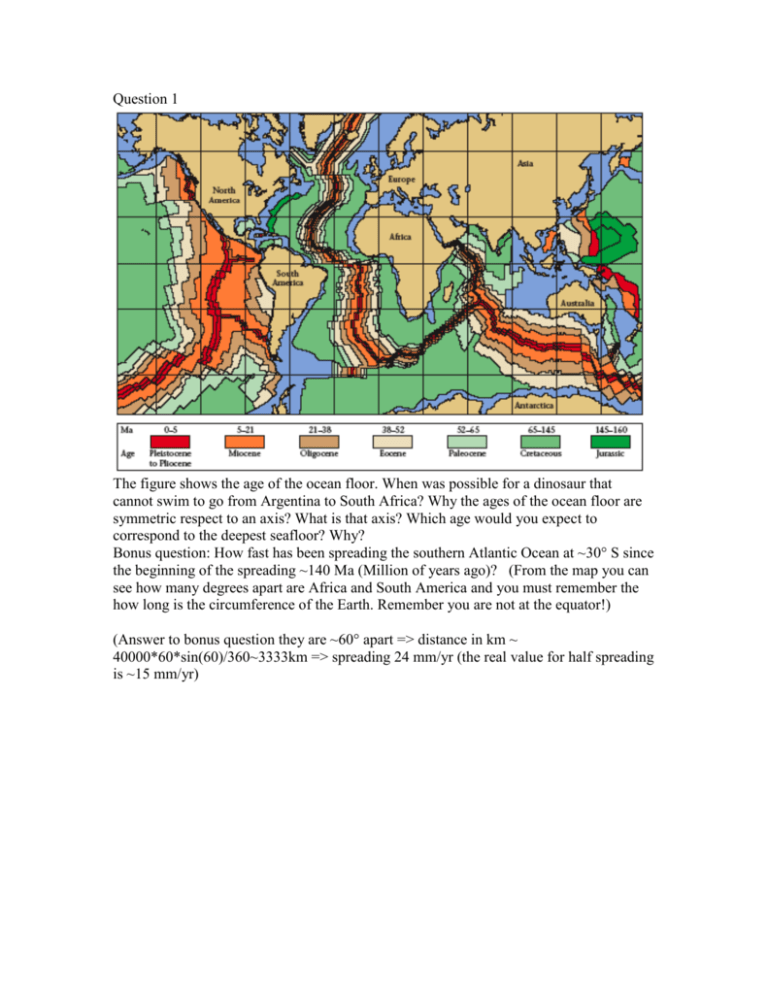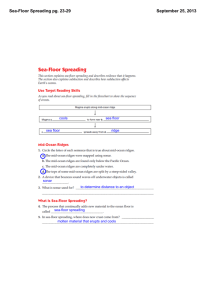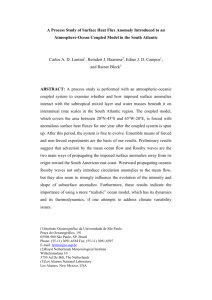Example Questions
advertisement

Question 1 The figure shows the age of the ocean floor. When was possible for a dinosaur that cannot swim to go from Argentina to South Africa? Why the ages of the ocean floor are symmetric respect to an axis? What is that axis? Which age would you expect to correspond to the deepest seafloor? Why? Bonus question: How fast has been spreading the southern Atlantic Ocean at ~30° S since the beginning of the spreading ~140 Ma (Million of years ago)? (From the map you can see how many degrees apart are Africa and South America and you must remember the how long is the circumference of the Earth. Remember you are not at the equator!) (Answer to bonus question they are ~60° apart => distance in km ~ 40000*60*sin(60)/360~3333km => spreading 24 mm/yr (the real value for half spreading is ~15 mm/yr) Question 2 The figure shows 3 stages of the formation of an ocean. Assuming that each time correspond to a magnetic reversal and that time 3 correspond to today, color on the figures the ocean floor corresponding to the normal polarity ocean floor. Why do the ocean floor became deeper moving away from the ridge? If the 3 times on the figure correspond to interval of 1 Myr (1 Million year) what would be a reasonable scale for the horizontal axis? Question 3 The figure shows the internal composition of the inner planets of the Solar system. Describe the Layers of Planet Earth. Describe 3 observations that you can use to justify that the center of the earth is denser. As you can see the other inner planets do not have outer core (or it is very small), how would you expect the magnetic field to be? Question 4 The figure is a cartoon scheme of the experiment of Eratosthenes to measure the circumference of the Earth. Assuming that it is correct and that the figure shows the situation at noon of the summer solstitium day, what are the coordinates of the 2 places (in theory they should be Alexandria and Syene but for that couple of city does not work too well…)? Since today we know the radius or circumference of the Earth, how distant are the 2 cities? Question 5 What is the Elastic Rebound theory? Question 6 Why do you think we can find deep earthquake only in subduction regions? Question 7 What are lithosphere and asthenosphere? How are thy related to plate tectonic? Question 8 The figure from Fowler shows different kind of gravity anomalies for different amount of Isostatic compensation. What is a gravity anomaly? What is Isostatic compensation? Can you make an example of Isostatic equilibrium? Why in general big mountains chain do not have the big gravity anomalies that we should expect from the excess of mass related to the mountain itself? Question 9 The figure shows a schematic view of the formation of the Hawaiian seamountain chain. How can you use the seamountain chain to say something about plate motion? Where would you expect to see the oldest volcanic rocks? Which assumption are we making when we speak of hot spot reference frame?










